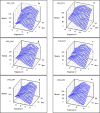Climate Change and Simulation of Cardiovascular Disease Mortality: A Case Study of Mashhad, Iran
- PMID: 28435826
- PMCID: PMC5395536
Climate Change and Simulation of Cardiovascular Disease Mortality: A Case Study of Mashhad, Iran
Abstract
Background: Weather and climate play a significant role in human health. We are accustomed to affects the weather conditions. By increasing or decreasing the environment temperature or change of seasons, some diseases become prevalent or remove. This study investigated the role of temperature in cardiovascular disease mortality of city of Mashhad in the current decade and its simulation in the future decades under conditions of climate change.
Methods: Cardiovascular disease mortality data and the daily temperatures data were used during (2004-2013) period. First, the correlation between cardiovascular disease mortality and maximum and minimum temperatures were calculated then by using General Circulation Model, Emissions Scenarios, and temperature data were extracted for the next five decades and finally, mortality was simulated.
Results: There is a strong positive association between maximum temperature and mortality (r= 0.83, P-value<0.01), also observed a negative and weak but significant association between minimum temperatures and mortality. The results obtained from simulation show increased temperature in the next decades in Mashhad and a 1 °C increase in maximum temperature is associated with a 4.27% (95%CI: 0.91, 7.00) increase in Cardiovascular disease mortality.
Conclusion: By increasing temperature and the number of hot days the cardiovascular disease mortality increases and these increases will be intensified in the future decades. Therefore, necessary preventive measures are required to mitigate temperature effects with greater attention to vulnerable group.
Keywords: Cardiovascular; Climate change; General circulation model; Maximum temperature.
Figures




Similar articles
-
Effect of Air Temperature and Universal Thermal Climate Index on Respiratory Diseases Mortality in Mashhad, Iran.Arch Iran Med. 2016 Sep;19(9):618-24. Arch Iran Med. 2016. PMID: 27631176
-
Part 2. Association of daily mortality with ambient air pollution, and effect modification by extremely high temperature in Wuhan, China.Res Rep Health Eff Inst. 2010 Nov;(154):91-217. Res Rep Health Eff Inst. 2010. PMID: 21446212
-
Multicity study of air pollution and mortality in Latin America (the ESCALA study).Res Rep Health Eff Inst. 2012 Oct;(171):5-86. Res Rep Health Eff Inst. 2012. PMID: 23311234
-
Heat and health in Adelaide, South Australia: assessment of heat thresholds and temperature relationships.Sci Total Environ. 2012 Jan 1;414:126-33. doi: 10.1016/j.scitotenv.2011.11.038. Epub 2011 Dec 12. Sci Total Environ. 2012. PMID: 22169392
-
Climate Changes and Human Health: A Review of the Effect of Environmental Stressors on Cardiovascular Diseases Across Epidemiology and Biological Mechanisms.Curr Pharm Des. 2017;23(22):3247-3261. doi: 10.2174/1381612823666170317143248. Curr Pharm Des. 2017. PMID: 28317479 Review.
Cited by
-
Effects of apparent temperature on cardiovascular disease admissions in rural areas of Linxia Hui Autonomous Prefecture.Sci Rep. 2023 Sep 11;13(1):14971. doi: 10.1038/s41598-023-42232-9. Sci Rep. 2023. PMID: 37696907 Free PMC article.
-
Analysis of the urban heat island in Łódź, Poland.Int J Occup Med Environ Health. 2024 Dec 18;37(6):581-590. doi: 10.13075/ijomeh.1896.02458. Epub 2024 Dec 12. Int J Occup Med Environ Health. 2024. PMID: 39670695 Free PMC article.
-
Analyzing the Interactions between Environmental Parameters and Cardiovascular Diseases Using Random Forest and SHAP Algorithms.Rev Cardiovasc Med. 2023 Nov 24;24(11):330. doi: 10.31083/j.rcm2411330. eCollection 2023 Nov. Rev Cardiovasc Med. 2023. PMID: 39076440 Free PMC article.
-
Heat and Cardiovascular Mortality: An Epidemiological Perspective.Circ Res. 2024 Apr 26;134(9):1098-1112. doi: 10.1161/CIRCRESAHA.123.323615. Epub 2024 Apr 25. Circ Res. 2024. PMID: 38662866 Free PMC article.
-
Analyzing cardiovascular disease hospitalization risks due to cold and heat waves in Dezful.Sci Rep. 2025 May 15;15(1):16879. doi: 10.1038/s41598-025-98736-z. Sci Rep. 2025. PMID: 40374799 Free PMC article.
References
-
- Parsons K. (2014). Human thermal environments: the effects of hot, moderate, and cold environments on human health, comfort, and performance. ed. Crc Press.
-
- Meade MS. (2010). Medical geography. ed. Wiley Online Library.
-
- Woodward A. (2014). Heat, cold and climate change. J Epidemiol Community Health, 68: 595–596. - PubMed
-
- McMichael AJ, Wilkinson P, Kovats RS, Pattenden S, Hajat S, Armstrong B, Vajanapoom N, Niciu EM, Mahomed H, Kingkeow C. (2008). International study of temperature, heat and urban mortality: the ‘ISOTHURM’project. Int J Epidemiol, 37: 1121–31. - PubMed
-
- Kovats RS, Hajat S. (2008). Heat stress and public health: a critical review. Annu Rev Public Health, 29: 41–55. - PubMed
LinkOut - more resources
Full Text Sources
